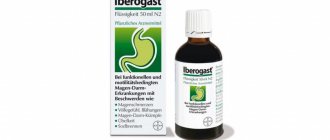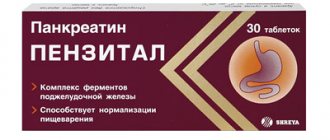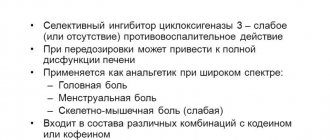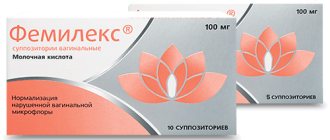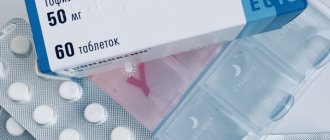Release form, packaging and composition of the drug Clinical-pharmacological group Pharmaco-therapeutic group Pharmacological action Indications for use Method of administration and doses Side effects Contraindications for use Use in children Special instructions Drug interactions
Registration Certificate Holder:
FP OBOLENSKOE, JSC (Russia)
ATX Code:
A03FA03
Active substance:
domperidone
Dosage form:
Passazhiks
| The drug is approved for use as an over-the-counter product | Passazhiks | Chewable tablets reg. No.: LS-000660 dated 06/25/10 - Valid |
Pharmacodynamics and pharmacokinetics
Pharmacodynamics
The effect of the drug is due to the ability of the active substance to increase the duration of contractions of the muscular layer of the stomach, enhance peristalsis of the duodenum and increase the tone of the sphincter between the stomach and esophagus. This helps ensure that after taking the drug the stomach empties faster, nausea and dyspeptic disorders are eliminated.
Domperidone is not able to influence the secretion of gastric juice.
Pharmacokinetics
Absorption of the drug occurs very quickly, but can be reduced if the acidity of gastric juice is reduced. Bioavailability is low - approximately 15%. After absorption, it is distributed throughout various tissues, except the brain, since domperidone is not able to penetrate the blood-brain barrier in large quantities. 91-93% bound to plasma proteins.
Metabolism of Passazhix occurs in the liver and intestinal walls. Excreted through the kidneys (33%) and intestines (66%), mainly in the form of metabolites . The half-life from the body is 7-9 hours, the duration may increase in case of renal failure .
pharmachologic effect
Passazhix is an antiemetic.
Pharmacodynamics
Increases the duration of peristaltic contractions of the antrum of the stomach and duodenum, accelerates gastric emptying if this process slows down, increases the tone of the lower esophageal sphincter, and eliminates the development of nausea and vomiting.
Domperidone poorly penetrates the blood-brain barrier (therefore, its use is rarely accompanied by extrapyramidal side effects, especially in adults), but it stimulates the release of prolactin from the pituitary gland. Its antiemetic effect may be due to a combination of peripheral (gastrokinetic) action and antagonism of dopamine receptors in the chemoreceptor trigger zone of the medulla oblongata. Domperidone has no effect on gastric secretion.
Pharmacokinetics
After taking the drug orally, domperidone is rapidly absorbed.
It has low bioavailability (about 15%). Reducing the acidity of gastric juice reduces the absorption of domperidone. Cmax in plasma is reached after 1 hour.
Domperidone is widely distributed in various tissues; its concentration in brain tissue is low. Plasma protein binding is 91-93%.
Subject to intensive metabolism in the intestinal wall and liver.
Excreted through the intestines (66%) and kidneys (33%), respectively 10 and 1% of the dose are excreted unchanged. T1/2 is 7-9 hours, with severe renal failure it lengthens.
Indications for use of Passazhix
Indications for use of tablets:
- symptoms associated with weakened stomach activity, in particular with delayed emptying;
- gastroesophageal reflux;
- esophagitis;
- heaviness in the stomach;
- bloating;
- belching , heartburn ;
- flatulence;
- nausea and vomiting , regardless of the cause.
Indications
- vomiting and nausea of various origins (including against the background of functional and organic diseases, infections, toxemia, radiation therapy, diet disorders;
- medicinal origin - taking morphine, apomorphine, levodopa and bromocriptine;
- when conducting endoscopic and radiopaque (the need to accelerate peristalsis) studies of the gastrointestinal tract;
- hiccups, gastrointestinal atony (including postoperative);
- dyspeptic disorders due to delayed gastric emptying, gastroesophageal reflux and esophagitis (a feeling of fullness in the epigastrium, a feeling of bloating, flatulence, gastralgia, heartburn, belching with or without reflux of gastric contents into the oral cavity).
Side effects
Side effects are very rare. These are transient symptoms that stop soon after stopping the drug.
Possible unwanted effects:
- allergic reactions: skin rash, urticaria ;
- intestinal spasms;
- extrapyramidal phenomena (with excessively high permeability of the blood-brain barrier);
- increased levels of prolactin in the blood and symptoms caused by hyperprolactinemia : galactorrhea , gynecomastia , dysmenorrhea .
Passazhix tablets, instructions for use (Method and dosage)
The instructions for use of Passazhix contain recommendations on how to use tablets for various forms of gastrointestinal disorders.
Chronic disorders:
- adult patients - 1 tablet (10 mg of active ingredient) three times a day before meals (20-30 minutes) and before bed, if necessary;
- children from 5 years old - take the medicine at the rate of 2.5 mg per 10 kg of weight before meals or bedtime three times a day, if necessary, the dosage can be increased.
Acute conditions ( nausea , vomiting ):
- adults – 3 or 4 times a day, 2 tablets before meals and bedtime;
- children (not younger than 5 years) – 3 or 4 times a day, half a tablet per 10 kg of weight before bedtime and meals.
Contraindications
- established intolerance to the drug and its components;
- prolactin-secreting tumor of the pituitary gland (prolactinoma);
- phenylketonuria;
- children under 5 years of age and children weighing up to 20 kg.
Passazhix should not be used when stimulation of gastric motility may be dangerous, incl. with gastrointestinal bleeding, mechanical obstruction or perforation.
With caution: renal/liver failure, lactation, pregnancy.
Overdose
Symptoms of overdose are:
- drowsiness;
- extrapyramidal phenomena;
- disorientation.
If you suspect that an overdose has occurred, you must drink Activated carbon . For extrapyramidal reactions, antihistamines , anticholinergics , and drugs used to treat Parkinson's disease may be effective .
Interaction
When using Passazhix, it is necessary to take into account how it can interact with other medications:
- with anticholinergic drugs - neutralization of the effect of Passazhix may be observed;
- with antisecretory and antacid drugs - bioavailability decreases;
- in in vitro studies, an increase in the concentration of the active substance in plasma was observed when combined with drugs that significantly inhibit CYP3A4, for example, with some antifungals, antibiotics , the antidepressant Nefazodone, and HIV protease ;
- it is assumed that Passazhix is capable of influencing the absorption of drugs that have a slow release type of active substance, or tablets coated with a coating that dissolves in the intestines.
Passazhiks chewable tablets 10 mg No. 10
Compound
Active substance: domperidone 10 mg
Excipients: aspartame, lactitol, xylitol, magnesium stearate, menthol.
Pharmacokinetics
Suction
After taking the drug orally, domperidone is rapidly absorbed. It has low bioavailability (about 15%). Reducing the acidity of gastric juice reduces the absorption of domperidone. Cmax in plasma is reached after 1 hour.
Distribution
Domperidone is widely distributed in various tissues; its concentration in brain tissue is low. Plasma protein binding is 91-93%.
Metabolism
Subject to intensive metabolism in the intestinal wall and liver.
Removal
Excreted through the intestines (66%) and kidneys (33%), unchanged - 10% and 1% of the dose, respectively. T1/2 is 7-9 hours.
Pharmacokinetics in special clinical situations
With severe renal failure, T1/2 is prolonged.
Indications for use
1) A complex of dyspeptic symptoms, often associated with delayed gastric emptying, gastroesophageal reflux, esophagitis:
- a feeling of fullness in the epigastrium, a feeling of bloating, pain in the upper abdomen;
- belching, flatulence;
- heartburn with or without reflux of stomach contents into the oral cavity.
2) Nausea and vomiting of functional, organic, infectious origin, caused by radiotherapy, drug therapy or diet disorders, as well as due to the use of dopamine agonists in Parkinson's disease (such as levodopa and bromocriptine).
Contraindications
- Established intolerance to the drug;
- prolactin-secreting tumor of the pituitary gland (prolactinoma);
- children under 5 years of age.
Passazhix should not be used when stimulation of gastric motility may be dangerous, incl. with gastrointestinal bleeding, mechanical obstruction or perforation.
Directions for use and doses
The drug is taken orally, preferably before meals. When taking the drug after a meal, absorption slows down somewhat.
Chronic dyspepsia
Adults are prescribed 10 mg (1 tablet) 3 times a day, 15-30 minutes before meals and, if necessary, before bedtime.
Children over 5 years old - 2.5 mg per 10 kg of body weight 3 times a day, before meals and, if necessary, before bedtime.
If necessary, the indicated dose can be doubled.
Acute and subacute conditions (primarily nausea and vomiting)
Adults are prescribed 20 mg (2 tablets) 3-4 times a day, before meals and before bedtime.
Children over 5 years old - 5 mg per 10 kg of body weight, 3-4 times a day, before meals and before bed.
In case of renal failure, it is recommended to reduce the frequency of taking the drug. In patients with severe renal failure (serum creatinine >6 mg/100 ml, i.e. >0.6 mmol/l), T1/2 of domperidone increased from 7.4 to 20.8 hours, but plasma concentrations of the drug were lower than in healthy volunteers . Because Since a very small percentage of the drug is excreted unchanged by the kidneys, single dose adjustment is hardly necessary in patients with renal failure. However, when re-prescribed, the frequency of administration should be reduced to 1-2 times a day, depending on the severity of renal failure, and it may also be necessary to reduce the dose. During long-term therapy, patients should be monitored regularly.
Given the metabolism of domperidone in the liver, the drug should be prescribed with caution to patients with liver failure.
Storage conditions
The drug should be stored out of the reach of children, in a dry place, protected from light, at a temperature not exceeding 25°C.
Best before date
2 years. Do not use the drug after the expiration date indicated on the package.
special instructions
When using Passazhix in combination with antacid or antisecretory drugs, the latter should be taken after meals and not before meals, i.e. they should not be taken at the same time as Passagix.
Description
Antiemetic - central dopamine receptor antagonist.
Use in children
The use of the drug in children under 5 years of age is contraindicated.
Pharmacodynamics
The drug has a prokinetic, antiemetic effect, normalizes the function of the gastrointestinal tract. Dopamine D2 receptor blocker. Prokinetic properties are associated with the blockade of peripheral dopamine receptors and the elimination of the inhibitory effect of dopamine on gastrointestinal functions. Increases the duration of peristaltic contractions of the antrum of the stomach and duodenum, accelerates gastric emptying if this process slows down, increases the tone of the lower esophageal sphincter, and eliminates the development of nausea and vomiting.
Domperidone poorly penetrates the BBB, so the use of domperidone is rarely accompanied by extrapyramidal side effects, especially in adults, but domperidone stimulates the release of prolactin from the pituitary gland. The antiemetic effect may be due to a combination of peripheral (gastrokinetic) action and antagonism of dopamine receptors in the chemoreceptor trigger zone. Domperidone has no effect on gastric secretion.
Side effects
Side effects are rare.
Allergic reactions: rarely - rash, urticaria.
From the digestive system: exceptional cases of transient intestinal cramps have been reported.
From the nervous system: in children and with increased permeability of the BBB, extrapyramidal reactions are observed, which are completely reversible and disappear spontaneously after cessation of treatment.
From the endocrine system: the drug can induce an increase in plasma prolactin levels (since the pituitary gland is located outside the BBB). In rare cases, hyperprolactinemia can stimulate the appearance of galactorrhea, gynecomastia and dysmenorrhea.
Use during pregnancy and breastfeeding
When administered to animals in doses up to 160 mg/kg/day, domperidone did not have a teratogenic effect. However, like most medications, the drug should be prescribed in the first trimester of pregnancy only if its use is justified by the expected therapeutic benefit. To date, there is no evidence of an increased risk of developmental defects in humans.
In women, concentrations of domperidone in breast milk are 4 times lower than the corresponding concentrations in plasma. It is unknown whether this level has a negative effect on newborns. Therefore, if a mother is taking Passagix, breastfeeding is not recommended unless the expected benefit justifies the potential risk.
Interaction
When used concomitantly, anticholinergic drugs may counteract the effect of Passagix.
When used simultaneously with Passazhix, antacid and antisecretory drugs reduce its bioavailability.
Based on in vitro studies, it can be assumed that with simultaneous use of Passazhix with drugs that significantly inhibit CYP3A4 (azole antifungals, macrolide antibiotics, HIV protease inhibitors, the antidepressant nefazodone), an increase in plasma domperidone concentrations may be observed.
The drug does not affect the concentration of paracetamol and digoxin in the blood.
It is possible that Passazhix may affect the absorption of drugs with a delayed release of the active substance or enteric-coated drugs used simultaneously orally.
Overdose
Symptoms: drowsiness, disorientation and extrapyramidal reactions, especially in children.
Treatment: The use of activated carbon and careful observation are recommended. Anticholinergics, drugs used to treat parkinsonism, or antihistamines may be effective if extrapyramidal reactions occur.
Impact on the ability to drive vehicles and operate machinery
Domperidone does not interfere with the speed of psychomotor reactions.
special instructions
When prescribing the drug Passazhix, it is necessary to take into account the characteristics of its effect on the body under various conditions. It may be necessary to change the dosage regimen or dosage of the active substance.
Directions for use of the medicine:
- In combination with antacids or antisecretory drugs: you can take only Passazhix before meals, and all other tablets after meals. The simultaneous use of these medications is prohibited.
- In case of liver failure : the metabolism of the active substance occurs in the liver, so it is necessary to prescribe tablets with extreme caution to patients whose liver function is impaired.
- For kidney diseases: if taken once, you can take the usual dose. But with long-term therapy, medical monitoring of the condition of the kidneys and dose adjustment, if necessary, is necessary.
Analogs
Matches by level 4 ATX code:
Motinorm
Domrid
Motilium
Itomed
Metoclopramide
Domperidone
Motilak
Ganaton
Cerucal
Analogues of Passazhix tablets are the following drugs:
- Domperidone;
- Motilium;
- Motilak;
- Motolium;
- Domstal;
- Domet;
- Motinorm;
- Motizhekt;
- Metoclopramide;
- Itomed;
- sturgeon;
- Damelium;
- Droperidol.
Passenger price, where to buy
The price of Passazhix in Russian pharmacies is up to 220 rubles, and in Ukrainian pharmacies it is about 115 hryvnia. Sold in most pharmacies.
- Online pharmacies in RussiaRussia
ZdravCity
- Passazhiks chewable tablets.
10 mg 30 pcs. JSC Obolenskoe farm. enterprise 318 rub. order - Passazhiks chewable tablets. 10 mg 10 pcs. JSC Obolenskoe farm. company
RUB 159 order
Release form, packaging and composition of the drug Passazhix
Chewable tablets
white or white with a creamy tint, round, flat-cylindrical, with a notch.
| 1 tab. | |
| domperidone | 10 mg |
Excipients
: aspartame, lactitol, xylitol, magnesium stearate, menthol.
4 things. — cellular contour packages (1) — cardboard packs. 4 things. — contour cell packaging (2) — cardboard packs. 4 things. — cellular contour packages (3) — cardboard packs. 4 things. — contour cell packaging (4) — cardboard packs. 4 things. — contour cell packaging (5) — cardboard packs. 6 pcs. — cellular contour packages (1) — cardboard packs. 6 pcs. — contour cell packaging (2) — cardboard packs. 6 pcs. — cellular contour packages (3) — cardboard packs. 6 pcs. — contour cell packaging (4) — cardboard packs. 6 pcs. — contour cell packaging (5) — cardboard packs. 10 pieces. — cellular contour packages (1) — cardboard packs. 10 pieces. — contour cell packaging (2) — cardboard packs. 10 pieces. — cellular contour packages (3) — cardboard packs. 10 pieces. — contour cell packaging (4) — cardboard packs. 10 pieces. — contour cell packaging (5) — cardboard packs.
